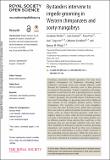Files in this item
Bystanders intervene to impede grooming in Western chimpanzees and sooty mangabeys
Item metadata
| dc.contributor.author | Mielke, Alexander | |
| dc.contributor.author | Samuni, Liran | |
| dc.contributor.author | Preis, Anna | |
| dc.contributor.author | Gogarten, Jan F | |
| dc.contributor.author | Crockford, Catherine | |
| dc.contributor.author | Wittig, Roman M | |
| dc.date.accessioned | 2021-11-29T15:30:04Z | |
| dc.date.available | 2021-11-29T15:30:04Z | |
| dc.date.issued | 2017-11-08 | |
| dc.identifier | 276613609 | |
| dc.identifier | f2b2ed95-8b89-4966-922b-2c978249b4f5 | |
| dc.identifier | 85033609160 | |
| dc.identifier | 29291114 | |
| dc.identifier.citation | Mielke , A , Samuni , L , Preis , A , Gogarten , J F , Crockford , C & Wittig , R M 2017 , ' Bystanders intervene to impede grooming in Western chimpanzees and sooty mangabeys ' , Royal Society Open Science , vol. 4 , no. 11 , 171296 . https://doi.org/10.1098/rsos.171296 | en |
| dc.identifier.issn | 2054-5703 | |
| dc.identifier.other | Bibtex: mielke2017bystanders | |
| dc.identifier.uri | https://hdl.handle.net/10023/24426 | |
| dc.description | A.M., A.P., L.S., C.C. and R.M.W. were supported by the Max Planck Society; A.M. was supported by the Wenner Gren Foundation (grant number 9095); A.P. was supported by the Leakey Foundation; L.S. was supported by the Minerva Foundation; J.F.G. was supported by an NSF Graduate Research Fellowship (DGE-1142336), the Canadian Institutes of Health Research's Strategic Training Initiative in Health Research's Systems Biology Training Program, an NSERC Vanier Canada Graduate Scholarship (CGS), and a long-term Research Grant from the German Academic Exchange Service (DAAD-91525837-57048249). Research at the Taï Chimpanzee Project has been funded by the Max Planck Society since 1997. C. C. was supported by the European Research Council (ERC) under the European Union's Horizon 2020 research and innovation programme (grant agreement no. 679787). | en |
| dc.description.abstract | Grooming interactions benefit groomers, but may have negative consequences for bystanders. Grooming limits bystanders' grooming access and ensuing alliances could threaten the bystander's hierarchy rank or their previous investment in the groomers. To gain a competitive advantage, bystanders could intervene into a grooming bout to increase their own grooming access or to prevent the negative impact of others' grooming. We tested the impact of dominance rank and social relationships on grooming intervention likelihood and outcome in two sympatric primate species, Western chimpanzees (Pan troglodytes verus) and sooty mangabeys (Cercocebus atys atys). In both species, rather than increasing their own access to preferred partners, bystanders intervened mainly when an alliance between groomers could have a negative impact on them: when the lower-ranking groomer was close to the bystander in rank, when either groomer was an affiliation partner whose services they could lose, or the groomers were not yet strongly affiliated with each other. Thus, bystanders in both species appear to monitor grooming interactions and intervene based on their own dominance rank and social relationships, as well as triadic awareness of the relationship between groomers. While the motivation to intervene did not differ between species, mangabeys appeared to be more constrained by dominance rank than chimpanzees. | |
| dc.format.extent | 16 | |
| dc.format.extent | 575978 | |
| dc.language.iso | eng | |
| dc.relation.ispartof | Royal Society Open Science | en |
| dc.subject | Interventions | en |
| dc.subject | Grooming | en |
| dc.subject | Sooty mangabey | en |
| dc.subject | Bystander | en |
| dc.subject | Chimpanzee | en |
| dc.subject | BF Psychology | en |
| dc.subject | DAS | en |
| dc.subject.lcc | BF | en |
| dc.title | Bystanders intervene to impede grooming in Western chimpanzees and sooty mangabeys | en |
| dc.type | Journal article | en |
| dc.contributor.institution | University of St Andrews. School of Psychology and Neuroscience | en |
| dc.identifier.doi | https://doi.org/10.1098/rsos.171296 | |
| dc.description.status | Peer reviewed | en |
| dc.identifier.url | https://royalsocietypublishing.org/doi/suppl/10.1098/rsos.171296 | en |
This item appears in the following Collection(s)
Items in the St Andrews Research Repository are protected by copyright, with all rights reserved, unless otherwise indicated.

